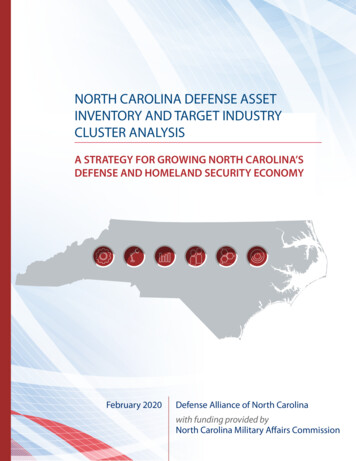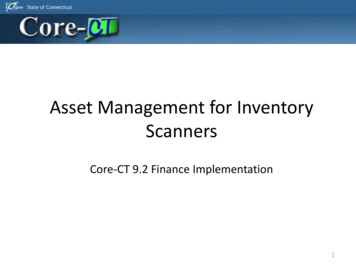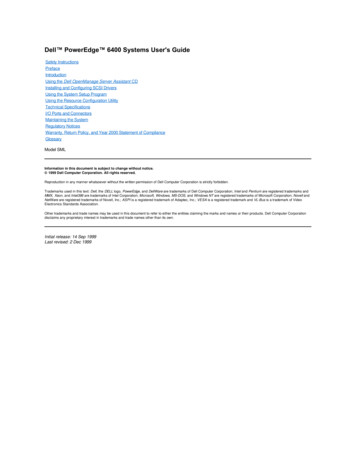
Transcription
NORTH CAROLINA DEFENSE ASSETINVENTORY AND TARGET INDUSTRYCLUSTER ANALYSISA STRATEGY FOR GROWING NORTH CAROLINA’SDEFENSE AND HOMELAND SECURITY ECONOMYFebruary 2020Defense Alliance of North Carolinawith funding provided byNorth Carolina Military Affairs Commission
Board of DirectorsChairLieutenant General Ken Glueck, US Marine Corps (Retired)Vice ChairChris Edge, Vice President—Large Business Customers, Duke EnergyDirectorsGeneral Dan McNeill, US Army (Retired)Major General Robert Dickerson, US Marine Corps (Retired)Major General J.B. Burns, US Army (Retired)Rear Admiral Rick Gromlich, US Coast Guard (Retired)Mike Bender, Director, Laboratory for Analytic Sciences, North Carolina State UniversityNathan Jones, Vice President—Federal Sales, Red HatTim Gabel, Executive Vice President, Social, Statistical, and Environmental Sciences, RTI InternationalTorrey Galida, President, Richard Childress RacingMike Brown, Vice President, Business Development—Outside Services, Richard Childress RacingRuth Anderson, President, RNE ConsultantsEmeritusFred Day IV, Former CEO/President, Progress Energy CarolinasGeneral Lance Smith, US Air Force (Retired)General James Lindsay, US Army (Retired)General Buck Kernan, US Army (Retired)Rear Admiral Paul Busick, US Coast Guard (Retired)StaffPaul Friday, Executive DirectorTammy Everett, Senior Director–2–
Table of ContentsBoard of Directors. 2Executive Summary. 4Findings.5Recommendations.8Introduction. 12Target Cluster Areas and Definitions.14Overall Findings. 17Assets by Target Cluster Area. 19Advanced Manufacturing.20Autonomous Systems.22Data and Knowledge Management.24Human Performance.26Materials.28Power.30Research, Development, and Education Assets . 32Recommendations. 35Acknowledgments. 40Appendix A: Data Resources and Methodology. 42Job Growth.42Advanced Manufacturing. 43Autonomous Systems. 43Data and Knowledge Management. 44Human Performance. 44Materials. 44Power. 44Supply Chain Purchasing.45Educational Assets and Graduates.46Company Lists and Existing Defense Work .47–3–
Executive SummaryNorth Carolina has a strong military presence with morethan 145,000 personnel representing five branches of themilitary, equating to the 4th largest military footprint in theUnited States.1 North Carolina also has an active networkof companies, universities, government, and economicdevelopment organizations providing products and servicesto support the bases, personnel, and veterans. Despitethe state’s strong military presence and active innovationecosystem, total dollars in defense contracts spent on NorthCarolina’s businesses and research organizations rank thestate as only 23rd in the country.2The Defense Alliance of North Carolina (DANC) has amission to grow North Carolina’s defense economy ina way that creates new long-term investments and jobopportunities. According to the 2019 North Carolina DefenseSupply Chain Analysis by the North Carolina DefenseIndustry Diversification Initiative, the top 3 North Carolinaindustry sectors in 2017 supplying goods or services to themilitary were (1) professional/technical/scientific services,(2) manufacturing (including food, textiles, chemicals,pharmaceuticals, fabricated metals, and electronics), and(3) construction.3 DANC is committed to enhancing thestrength of North Carolina’s existing defense supply chains.To consider how North Carolina might grow its defenseeconomy, DANC led a study to identify where NorthCarolina’s capabilities intersect with six future technologyarea priorities of the US Department of Defense (DoD) thatcould be the basis of forming technology cluster areas for NC.Defense Manpower Data Center. (n.d.). DoD Personnel, Workforce Reports & Publications. Retrieved from https://www.dmdc.osd.mil/appj/dwp/dwp reports.jsp2. Department of Defense, Office of Economic Adjustment. (March 2019). Defense Spending by State, Fiscal Year 2017.Retrieved from Y2017 Defense Spending by State ReportWeb Version 20190315.pdf3. North Carolina Defense Industry Diversification Initiative, NC State Industry Expansion Solutions, and North CarolinaDepartment of Military and Veterans Affairs. (2019). NC Defense Supply Chain Analysis. Retrieved from sr.com/ugd/df24ba bb1ae112a15643ad8e648561084578ef.pdf1.–4–
This report contains the results of the study, which was funded by the NorthCarolina Military Affairs Commission with research and analysis conductedby RTI International and the North Carolina Department of Commerce.Informing this study was a core team representing 11 organizations fromacross North Carolina, with input from more than 30 industry, government,military, nonprofit, and academic organizations that continue to worktogether to support and build North Carolina’s defense economy. The teamidentified six technology areas, then analyzed North Carolina economic data,identified innovation assets and capabilities, and interviewed companies toidentify barriers to obtaining defense contracts. The six technology areas areas follows: advanced manufacturing human performance autonomous systems materials data and knowledgemanagement powerFindingsEconomic data analysis shows that while North Carolina is a small overallmarket for defense business in each technology area, it is among the fastestgrowing states in the nation for jobs in the target areas. Over the past 5years, the state ranked 1st in economic growth in data and knowledgemanagement and human performance, 2nd in power and advancedmanufacturing, and 6th in autonomous systems. Materials was the onlysector to experience a decline, mirroring national trends. Additionally, NorthCarolina has a high concentration of jobs in research and services related tothe six technology areas compared with the national average.The study team targeted nondefense companies in North Carolina withineach technology cluster area and interviewed them to understand why thesecompanies are not pursuing defense as a market. The team also spoke with afew defense contractors to gain their perspectives on the opportunities andchallenges with conducting defense business in North Carolina. Feedbackincluded an unawareness of opportunities specific to their capabilities;difficulties in navigating defense proposal, contracting, and accountingprocesses; expense and time required to meet DoD quality, cyber security,and other requirements; and perceived less lucrative business opportunitiesin defense than in their current commercial markets.–5–
The study uncovered innovation assets and capabilitiesin research centers, talent, and industry that can supportgrowing the six technology areas. A sampling of notableassets includes the following by area: Advanced manufacturing—Assets in this area includemajor additive manufacturing (AM) production facilitiesat Oerlikon’s 55 million Innovation Hub & AdvancedComponent Production facility in Huntersville and at largeNorth Carolina contract manufacturer Protolabs; researchfacilities at North Carolina State University’s (NCSU’s)Center for Additive Manufacturing and Logistics; NorthCarolina companies and organizations are active in atleast eight of the Manufacturing USA institutes, includingbiomanufacturing and advanced textiles, two existingindustry strengths for the state. Autonomous systems—Assets in this area include testingplatforms for autonomous vehicles at North CarolinaAgricultural and Technical State University’s TECHLAV andthe National Science Foundation–funded 5G drone AerialExperimentation and Research Platform for AdvancedWireless (AERPAW) at North Carolina State University; DukeUniversity’s Humans and Autonomy Lab, which focuses onhuman and computer decision-making in complex systemswith embedded autonomy; and ABB’s Corporate ResearchCenter that includes work in robot intelligence. Data and knowledge management—Assets in thisarea include IBM’s first North American Q Hub at NCSUto advance quantum computing; data analytics andcomputing powerhouses SAS, IBM, and Red Hat; andRenaissance Computing Institute, a high- performancecomputing data and networking research center. Human performance—Assets in this area includeNorth Carolina’s biotechnology industry, with the entireinnovation ecosystem of research and development (R&D),clinical testing, manufacturing, and hospital end userslocated within the state; the Armed Forces Institute ofRegenerative Medicine led by Wake Forest University; theNorth Carolina Research Campus in Kannapolis that focuseson human health through nutrition; and gaming andvirtual reality training companies such as Epic Games andVirtual Heroes.–6–
Materials—Assets in this area include companies makinghigh-tech engineered and functional fabrics facilitated bythe Nonwovens Institute and connected to the AdvancedFunctional Fabrics of America manufacturing innovationcenter and the Research Triangle Nanotechnology Network,a National Science Foundation–funded organization atResearch Triangle Park–area universities that includesnanofabrication and characterization capabilities. Power—Assets in this area include leaders in nextgeneration power electronics, including wide bandgapsemiconductors, that enable lightweight high-powersystems for portable power, electric vehicles, andalternative power generation with companies CreeWolfspeed, Qorvo, and Kyma Technologies; North CarolinaState’s FREEDM Systems Center; and Power America, the 140 million power electronics manufacturing innovationcenter; the headquarters of Duke Energy, one of the largestenergy utilities in the United States with its headquartersand new innovation center located in Charlotte; theElectric Power Research Institute and its InternationalElectrification 2020 Conference; and power storage systemsmanufacturers such as Clarios and Celgard.Approximately 12% of North Carolina companies withinthese technology areas have defense contracts. Tounderstand why more North Carolina companies werenot in the defense market, the research team includedinterviews with companies in each technology area. Themain reasons companies cited were (1) lack of awareness ofopportunities relevant to their businesses; (2) difficulties innavigating government proposals, contracting, accounting,and quality requirements; and (3) for some, greater financialopportunities in commercial markets.–7–
RecommendationsConcentratinggrowth activities onsix technology areasimportant to the futureof the DoD will helpNorth Carolina focusand leverage resourcesfor an intentional,strategic approach witha better likelihoodfor success.To grow the defense industry in North Carolina, the statecan consider two strategies: one that helps industry benefitfrom local opportunities and one that helps industry accessdefense and national security opportunities nationwide.For a local strategy, North Carolina can assist as requestedto grow the military footprint; attain new commands oracquisition offices; increase the number of personnel;connect commands with research needs to local universitiesand research centers; and ensure that as many supplies andequipment, service, and construction contracts let by theinstallations go to local businesses. North Carolina can buildon its success in this area because of the ongoing efforts ofmany people in state government such as the North CarolinaDepartment of Military and Veterans Affairs; the Departmentof Commerce; and organizations like DANC, the EconomicDevelopment Partnership of North Carolina, the NorthCarolina Economic Development Association, the NorthCarolina Military Business Center, the North Carolina DefenseTechnology Transition Office, and the North Carolina DefenseIndustry Diversification Initiative. Deeper and sustainedrelationships with both uniformed and civilian leaders at theNorth Carolina installations are critical to this strategy.Looking at the broader needs of the DoD beyond supportinglocal installations opens up a world of opportunity forNorth Carolina. The DoD has current and future needs forinnovative solutions to enable the United States to continueto dominate in worldwide defense. These needs translateto contracts for research, products, and services that canbe sourced from anywhere, and North Carolina businesses,organizations, and talent are well positioned to competefor and win these contracts. Concentrating growth activitieson six technology areas important to the future of the DoDwill help North Carolina focus and leverage resources for anintentional, strategic approach with a better likelihood forsuccess.–8–
The following recommendations were developed throughconversations with companies and organizations in the state,analysis of North Carolina’s innovation assets and capabilitieswithin six DoD technology areas slated for growth, andinsight from contributors listed in the Acknowledgementswho have domain experience within the DoD and regularlyengage with national security programs. While many ofthe following suggested activities exist today in areas ofNorth Carolina’s DoD strengths (e.g., military construction,textiles) or in areas of installation needs (e.g., the Hacking forDefense program), these recommendations are a response toneeds articulated from nondefense companies interested inpursuing defense contracts.To implement the recommendations of this report, DANCintends to create action plans and facilitate teams ofeconomic development organizations, military supportorganizations, industry members, and academic partners.One team will address overarching recommendations thatcan support the six technology areas as well as existing NorthCarolina DoD sector areas of strength, and six teams willfocus on building each technology area by implementingtheir specific recommendations.–9–
I.Networking and Collaborationa.Provide opportunities and venues for the local innovation ecosystem in each of thetechnology areas to engage with the DoD and national security customers to identifyopportunities to transition research out of academic labs to the government andcommercial sectors.b.Host “innovation days” to showcase North Carolina’s nontraditional and entrepreneurialcompanies to both the DoD and venture capital funders.c.Proactively connect teams of researchers, startups, and companies to DoD end userswithin each technology cluster area using human-centered design to spur newinnovation and provide opportunities for North Carolina organizations to betterunderstand defense customer operating cultures and needs.d.Provide mentoring and peer-to-peer interactions and functional integration betweenthe varied practitioners and stakeholders, both within and across the cluster areas,giving nondefense companies the opportunity to learn from and partner withprime contractors.II. Contracting Assistancea.Raise companies’ awareness of existing resources and training to help them navigateproposal writing, accounting, and contracting requirements.b.Build a directory of service providers with DoD contracting experience.c.Partner primes with DoD experience with companies new to DoD contracts as part ofthe DoD Mentor Protégé program.III. Removal of Barriers to Entrya.Promote certifications in ISO 9001, AS 9100, International Traffic in Arms Regulations(ITAR), Cybersecurity Maturity Model Certification (CMMC), and NIST 800-171 tostrengthen companies’ ability to conduct DoD business.b.Assign one coordinating organization to manage third-party service providers incertifications and training to make it easier for companies to navigate the complexitiesof DoD contracting.c.Incentivize companies to consider entering the DoD market by educating them aboutrevenue opportunities and access to Small Business Innovation Research nondilutivecapital and to consider creative tax incentives for capital equipment or revenue fromdefense contracts.IV. Agency Outreacha.Develop marketing materials for North Carolina’s value proposition in the sixtechnology areas and communicate that information to DoD funders andprime contractors.– 10 –
b.Recruit a major DoD acquisition, rapid innovation office, or best practices work cellsto the region to increase visibility of North Carolina’s innovation capability and attracthigh-tech and high-performing companies to North Carolina.c.Position North Carolina to be home of a new national technology center in one ofthe six technology areas, such as quantum for data and knowledge management,emerging biotechnology for national security for human performance, or a groundvehicles center of excellence for advanced manufacturing.V. Specific Technology Areasa.Advanced manufacturing—Create an additive manufacturing (AM) materialscharacterization database and membership organization, identify or attract pre-andpost-processing services, develop a catalog of AM providers, and build awareness forrural tool/die and contract manufacturing companies on AM opportunities. Considerestablishment of a ground vehicles center of excellence using the AM expertise ofNorth Carolina’s motorsports industry.b.Autonomous systems—Leverage AERPAW and other testing platforms to attractteams proposing to the DoD, use the Drone Summit to attract funders and relevantcompanies to network, match artificial intelligence companies with transportationcompanies and with decision-support software companies in the state to pursueautonomous systems opportunities.c.Data and knowledge management—Provide broadband infrastructure to enablecompanies working in the digital space to connect with customers, make availablespecialized infrastructure (e.g., Sensitive Compartmented Information Facility) to workin secure spaces, and develop cybersecurity resources and service providers to assistcompanies working in defense.d.Human performance—Leverage the North Carolina Biotechnology Center as the hubof human performance activities and broaden from there, embrace North Carolina’shuman health innovation ecosystem to address warfighter performance needs, andwork with virtual reality labs and interested gaming companies to develop warfightertraining applications.e. Materials—Focus on functional fabrics and nanomaterials and identify DoD needs andfunding for applications such as heating/cooling, communications, and color-changingclothing and materials.f. Power—Partner power electronics companies with those developing applicationsfor the DoD to take advantage of the lightweight and increased power capacity forthe military; provide access to high-voltage R&D facilities for these companies; andleverage the industry and research connections of Power America, the North CarolinaCleantech Cluster, and the University of North Carolina–Charlotte’s Energy Productionand Infrastructure Center.– 11 –
IntroductionNorth Carolina plays an important role in the defenseinfrastructure of the United States: it is the 4th largest statein terms of total Department of Defense (DoD) personnelwith over 146,000 people stationed in the state at the endof 2018.4 However, it is a small market for defense businessrelative to its size: it ranks 23rd in DoD contracting at 3.3billion, with only 3% of that contracting going to researchand development (R&D).5 Most defense business in thestate, in dollar value, is contracting for services, supplies,and construction at large installations in the state. As partof its mission to grow North Carolina’s defense economyin a way that creates new long-term investments and jobopportunities, the Defense Alliance of North Carolina (DANC)is working to position businesses in the state to be morecompetitive in the defense market space in general and,via this study, in six emerging sectors of defense business,particularly in high-tech and high value-add sectors withpotential for future defense applications.Capabilities and innovation assets reside in the organizationsin the state—the businesses new and existing, large andsmall; the universities and research organizations; thecommunity colleges and educational institutions; and theeconomic development organizations and state and localgovernments. Assets include physical and programmaticinfrastructure, intellectual property (IP), and talent.Infrastructure includes labs to create new discoveries,broadband to connect businesses to customers, airports/highways/ports to move goods and people, researchprograms that provide the framework for researchers tocreate new discoveries, and entrepreneurship programs thatconnect innovators to service personnel. IP is embeddedin business and people, including trade secrets in howbusinesses create value by making products or providingservices, and patents that protect new inventions. TalentDefense Manpower Data Center. (n.d.). DoD Personnel, Workforce Reports & Publications. Retrieved from https://www.dmdc.osd.mil/appj/dwp/dwp reports.jsp5. Department of Defense, Office of Economic Adjustment. (March 2019). Defense Spending by State, Fiscal Year 2017.Retrieved from Y2017 Defense Spending by State ReportWeb Version 20190315.pdf4.– 12 –
resides in North Carolina’s people, those who are working inbusinesses and organizations who possess the know-howto create solutions, make products, and provide services;those with new ideas who possess the drive to create newbusinesses; those being trained and graduating from schoolsto bring new insights to businesses and organizations; andthose coming out of the many military installations in ourstate who have the domain knowledge and desire to makethings better so the warfighter can complete his/her mission.DANC, along with RTI International, the North CarolinaDepartment of Commerce Labor and Economic AnalysisDivision (LEAD), and key partners and advisors from acrossthe state, sought to examine future target cluster areas forgrowth, map the state’s assets in each of the target clusterareas, identify strengths and gaps, and map a strategy tostrengthen the defense business sector in North Carolina.This report and subsequent action plans are the result ofthat effort. It is hoped that the implementation strategiesthat emerge from this study can serve as a model to improveopportunities for North Carolina companies and academiaacross all of our market areas.The purpose of this report is to provide actionableinformation that can help North Carolina’s businesses,economic developers, academic organizations, and defensebusiness support ecosystem partners increase the amount ofDoD contracts for North Carolina, particularly for products,services, and research that can support any area of the DoDincluding and beyond North Carolina’s local installations.The goal is to build North Carolina’s clusters in areas that cansupport future areas of growth for the DoD, drawing on thestate’s capabilities and innovation assets to capture thosefuture investments.– 13 –
Target Cluster Areas and DefinitionsThe team defined the six target cluster areas based on a review of DoDstrategic, forward looking documents and needs descriptions with input bymilitary and state military business experts. They are based on a combinationof North Carolina’s strengths as a state and future strategy documents andannouncements for DoD funding in the future. The cluster areas are meantto reflect how North Carolina can contribute to transformative trends intechnologies for the warfighter and create high-value businesses in thefuture, beyond routine services such as construction or food service for bases.The goal is to identify North Carolina’s capabilities throughout the entireinnovation life cycle. For each cluster area, the research team identifiedindustry sectors, organizations, and companies that support the entireinnovation life cycle from R&D to products and services. – 14 –
Each of the target cluster areas, outlined in Table 1, cuts across varioussectors, and many have overlapping assets and capabilities. Certaincompanies or industries may be involved in multiple target cluster areas. Table 1: Target Cluster AreasTarget Cluster AreaDefinitionAdvancedManufacturingIncludes newer manufacturing methods that can supportthe warfighter in the field, such as additive manufacturing(AM), methods for lightweighting equipment, and quality/reliability testing methods to ensure part performance.Autonomous SystemsA cross-cutting sector that includes smart, self-directedsystems, including unmanned air, ground, and watervehicles. Includes robotics, self-healing networks, humanmachine interaction, and artificial intelligence (AI)/machine learning.Data and KnowledgeManagementCombination of processing, storing, analyzing,protecting, and creating knowledge from data; includescybersecurity—protection from cyber attack, systemresilience, assurance, and cyber forensics. Futuretechnologies include quantum computing.Human PerformanceIncludes augmenting, assisting, and protecting humans tooptimize performance This can include pharmacogenetics,microbiome, AI-powered diagnostics, regenerativemedicine, wearable health monitors, and prostheticsintegrated with the nervous system. Also includes humanpsychology, social behavior, and human factors andsystems.MaterialsIncludes new materials to enable warfighter advantage,such as nanomaterials, ceramics, lightweight metal alloys,composites, flexible electronics, and functional fabrics.PowerA mix of traditional and nontraditional energy and powertechnologies that reduce size and weight and enhanceelectronic equipment performance, including energyproduction, harvest, storage, and distribution; batteries;microgrids; power electronics; and waste-to-energysystems.– 15 –
In reviewing the target cluster areas and their potential forforming the next generation of defense business work inNorth Carolina, the research team reviewed the followingdata to benchmark and position the state: Jobs, job growth, and location quotient (LQ) Size of the supply chain and percentage of purchases madein state Number of companies directly involved in defensebusiness and those with the potential to enter the defensebusiness market Number of higher education programs and numbers ofassociate’s, bachelor’s, and advanced degrees grantedTogether, the data presented show the size and potential ofthe assets in the state related to the target cluster areas: notall the companies, supply chains, jobs, or degrees reportedare directly involved in defense business, and in manycases, defense business makes up a small percentage of theoverall economic activity created by the sectors. Appendix Aprovides a full overview of the data and methodology.– 16 –
Overall FindingsNorth Carolina is a relatively small market for defense business whenmeasured by DoD contracting: despite being the 4th largest state in militarypersonnel and 9th largest in population, the state ranks 23rd in value of DoDcontracts awarded to companies in the state, which are mainly awards forbase construction, services, and maintenance. Only 3% of the contractingdollars in the state are in R&D.Similarly, the size of the existing market in the cluster areas in North Carolinais relatively small compared with its competitors. Table 2 shows the numberof jobs in North Carolina within each cluster area. When viewing relativeconcentration by LQ,6 all the sectors were at or below the national average. Table 2: Size and Specialization of Target Cluster Areas in North Carolina: 2018Jobs in North CarolinaNorth Carolina LQ*North Carolina NationalRankAdvanced Manufacturing47,0170.9213thAutonomous Systems103,2230.7816thData and KnowledgeManagement130,3370.9714thHuman wer54,2781.0311th4.4 millionN/A9thCluster AreaNorth Carolina, totalSources: Bureau of Labor Statistics. (2018). Quarterly Census of Employment and Wages (QCEW). Retrieved from https://www.bls.gov/cew/. Targetcluster area industry code definitions are in the appendix.Despite being a smaller market in the target cluster areas, North Carolinais among the fastest growing states in the nation: from 2013 to 2018 thestate ranked 1st in
Feb 26, 2020 · (2) manufacturing (including food, textiles, chemicals, pharmaceuticals, fabricated metals, and electronics), and (3) construction.3 DANC is committed to enhancing the strength of North Carolina’s existing defense supply chains. To consider how North Carolina might grow its defense









